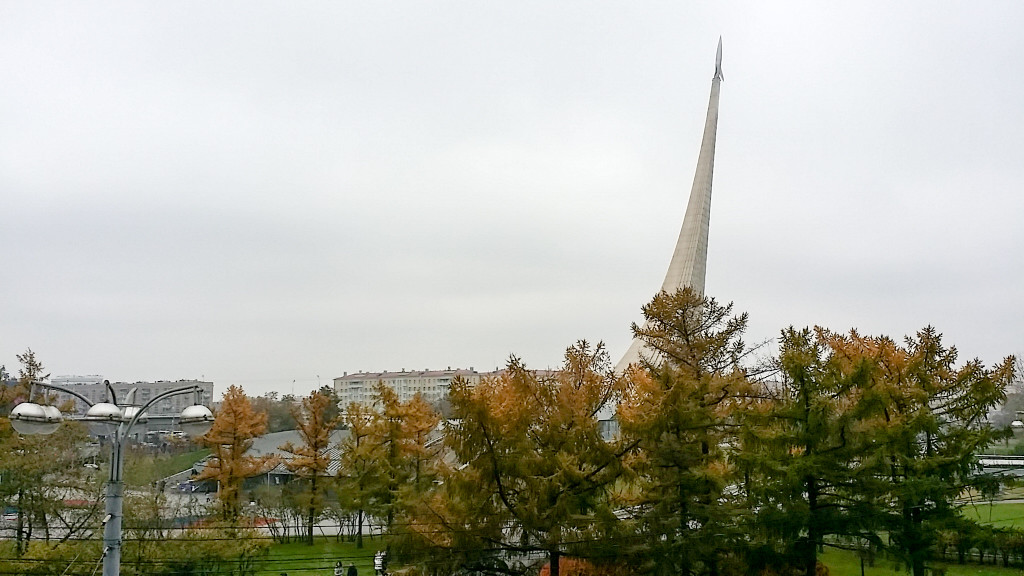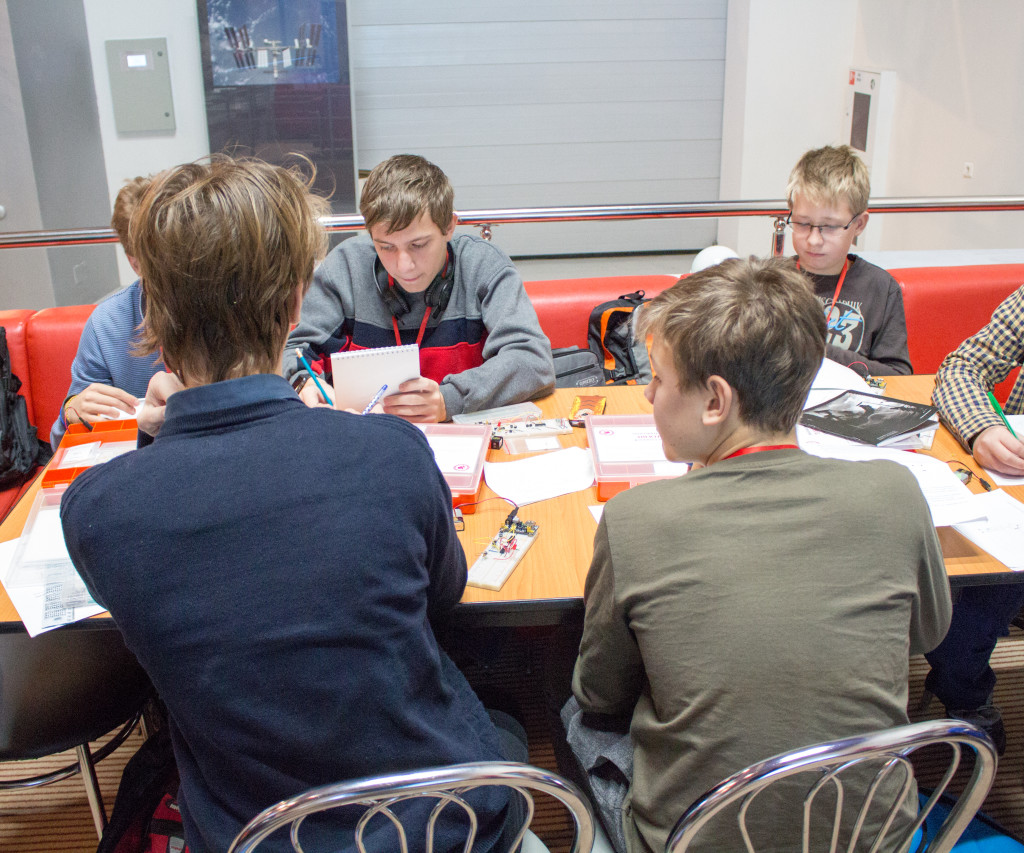Report on a visit to the study of the basics of digital circuitry at the Cosmonautics Museum in Moscow
When I was a little boy, my favorite book was Earth and Sky. She still stands on my shelf:
Then in 1st grade I went to Moscow, went to VDNKh to the Cosmos pavilion, and met with great interest there the rover. And recently, 38 years later, I repeated my acquaintance:
True, he was not standing in the Cosmos pavilion, but in the Cosmonautics Museum near VDNKh, in a building under a rocket taking off: Anton Mikhailov , the organizer of the study circle,
invited me to come into the cosmonautics museum children basics of electronics called the Design Bureau "East" . I met Anton Mikhailov through Ruslan Tikhonov from http://amperka.ru .



Anton Mikhailov also collaborates with N.E. Bauman Moscow State Technical University, where he is planning to hold a digital circuitry competition for schoolchildren on December 19 .
When I came to the Cosmonautics Museum, I was primarily guided by a guide, a young man who personally interacted with a bunch of astronauts, and, as far as I remember, was involved in the Cossack movement. I said that the microprocessors developed by our company Imagination Technologies (formerly MIPS Technologies) are used both in the spacecraft of the Japan Aerospace Research Agency JAXA and in the American spacecraft that flies to Pluto . In addition, now our companycooperates with the Russian company Elvis Scientific and Production Center , which also develops microcircuits for satellites and originally grew from the Soviet enterprise ELAS, which developed electronics for the Salyut and MIR space stations .
Finally, I met Anton Mikhailov: And Ruslan Tikhonov: They developed a set for teaching schoolchildren the basics of digital circuitry based on prototyping boards and microcircuits of small degree of integration, which contain logic elements, D-flip-flops, counters and clock generators: That reader may exclaim: “Why this is?! XXI Century! Children need Arduino, Lego, Razberry Pie! ”



Alas, Lego / Arduino / Razberry Pie can teach you how to program microcontrollers and connect the finished peripherals to them, but they do not show how you can design the microcontroller / integrated processor on the basis of which Arduino / Razberry Pie is made. To take the first step, the student must clearly understand the concepts of logic elements, D-flip-flops and clock signals. These are three fundamental bricks, without which there is no way, and it is better to understand these concepts not on the simulator and on the FPGA / FPGA, but on microcircuits with a small degree of integration - this is more obvious, especially for children.
I wrote about this before ( How and why to start teaching junior schoolchild in digital electronics ? , Electronics kit for the Informaticsum robotics club ).
An example of a board assembled from a similar American Gibson kit: After such exercises, the most advanced senior schoolchildren can be transferred to the FPGA / FPGA - see "How to start developing hardware using the FPGA - step-by-step instruction" After our meeting with Anton and Ruslan, they began to study the circle. I gave a speech to schoolchildren with a story about Silicon Valley, as well as how lucky they are - they will be the first generation of electronic engineers who can, without emigrating, work in Russia “according to the Hamburg account”, that is, have access to the global development ecosystem (EDA tools, semiconductor IP), participate in international projects in joint US-European-Russian-Asian teams

, and also have access to international venture capital and markets for their developments.
The children listened with interest and began their studies: In the end, Anton Mikhailov gave them a test: And now a little material for adults: A Japanese spaceship with the proud name of Hayabusa-2 (Falcon), which is now flying to the asteroid 1999 JU3, is controlled by a processor HR5000 based on the MIPS 5Kf processor core, licensed for a long time by MIPS Technologies. Datasheet on HR5000 And here is the datasheet on its core MIPS 5Kf The structure of the processor pipeline of this core: And the MIPS 5Kf bus protocol called EB (External Bus).









Anton Mikhailov also collaborates with N.E. Bauman Moscow State Technical University, where he is planning to hold a digital circuitry competition for schoolchildren on December 19 .
When I came to the Cosmonautics Museum, I was primarily guided by a guide, a young man who personally interacted with a bunch of astronauts, and, as far as I remember, was involved in the Cossack movement. I said that the microprocessors developed by our company Imagination Technologies (formerly MIPS Technologies) are used both in the spacecraft of the Japan Aerospace Research Agency JAXA and in the American spacecraft that flies to Pluto . In addition, now our companycooperates with the Russian company Elvis Scientific and Production Center , which also develops microcircuits for satellites and originally grew from the Soviet enterprise ELAS, which developed electronics for the Salyut and MIR space stations .
Finally, I met Anton Mikhailov: And Ruslan Tikhonov: They developed a set for teaching schoolchildren the basics of digital circuitry based on prototyping boards and microcircuits of small degree of integration, which contain logic elements, D-flip-flops, counters and clock generators: That reader may exclaim: “Why this is?! XXI Century! Children need Arduino, Lego, Razberry Pie! ”



Alas, Lego / Arduino / Razberry Pie can teach you how to program microcontrollers and connect the finished peripherals to them, but they do not show how you can design the microcontroller / integrated processor on the basis of which Arduino / Razberry Pie is made. To take the first step, the student must clearly understand the concepts of logic elements, D-flip-flops and clock signals. These are three fundamental bricks, without which there is no way, and it is better to understand these concepts not on the simulator and on the FPGA / FPGA, but on microcircuits with a small degree of integration - this is more obvious, especially for children.
I wrote about this before ( How and why to start teaching junior schoolchild in digital electronics ? , Electronics kit for the Informaticsum robotics club ).
An example of a board assembled from a similar American Gibson kit: After such exercises, the most advanced senior schoolchildren can be transferred to the FPGA / FPGA - see "How to start developing hardware using the FPGA - step-by-step instruction" After our meeting with Anton and Ruslan, they began to study the circle. I gave a speech to schoolchildren with a story about Silicon Valley, as well as how lucky they are - they will be the first generation of electronic engineers who can, without emigrating, work in Russia “according to the Hamburg account”, that is, have access to the global development ecosystem (EDA tools, semiconductor IP), participate in international projects in joint US-European-Russian-Asian teams

, and also have access to international venture capital and markets for their developments.
The children listened with interest and began their studies: In the end, Anton Mikhailov gave them a test: And now a little material for adults: A Japanese spaceship with the proud name of Hayabusa-2 (Falcon), which is now flying to the asteroid 1999 JU3, is controlled by a processor HR5000 based on the MIPS 5Kf processor core, licensed for a long time by MIPS Technologies. Datasheet on HR5000 And here is the datasheet on its core MIPS 5Kf The structure of the processor pipeline of this core: And the MIPS 5Kf bus protocol called EB (External Bus).






Only registered users can participate in the survey. Please come in.
What do you want to teach schoolchildren?
- 66.1% Fundamentals of Mathematical Logic and Electricity 39
- 40.6% Analog Circuits on a breadboard 24
- 30.5% Digital circuits on a breadboard using discrete elements (transistors) 18
- 40.6% Digital circuits on a breadboard using low-level integrated circuits (TTL 7400, CMOS 4000) 24
- 18.6% Digital circuits on FPGA / FPGA, with graphic input of the circuit by drawing with the mouse on the screen 11
- 15.2% FPGA / FPGA digital circuits, with synthesis from Verilog at the level of register exchanges 9
- 10.1% FPGA / FPGA digital circuits, with synthesis from VHDL at the level of register exchanges 6
- 11.8% FPGA / FPGA Digital Circuits 7
- 27.1% Microcontroller programming in a Lego environment 16
- 44% Programming microcontrollers in an Arduino environment or analogs (MPIDE) 26
- 20.3% Microcontroller programming with professional tools (e.g. MPLAB X for Microchip PIC32) 12
- 28.8% Programming Embedded Microprocessors in Raspberry Pi 17 Environments
- 28.8% Programming in Pascal on a large computer 17
- 15.2% Haskell and Lisp 9 Programming
- 8.4% None of this is necessary, it is better to increase courses in algebra and geometry 5
- 11.8% None of this is necessary, it is better to increase the courses of physics, chemistry and biology 7
- 6.7% None of this is necessary, it is better to increase the courses of literature, history and introduce something ethical 4
- 3.3% Other (explain in comments) 2
